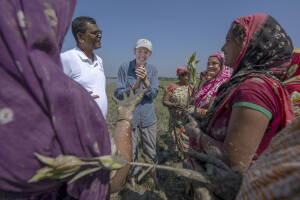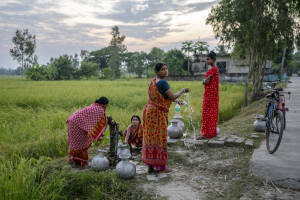Before a carbon project is allowed onto the Cool Effect platform, our team thoroughly vets its science and financials to ensure that it’s viable, high quality and meets our Carbon Done Correctly criteria. Even then, there are some things that numbers can’t tell you. In order to get the full story on a potential Cool Effect project, a large part of our vetting process involves site visits from our team in order to see that carbon project’s community impact — The Good On The Ground — up close and in person.

That process is what led us to the Sundarbans, a cluster of low-lying islands in the Bay of Bengal, an active delta that spans around 40,000 sq km and lies half underwater. Within the Sundarbans you’ll find the Sundarbans mangrove forest, a 10,000 sq km stretch of forest that spans India and Bangladesh and is home to many rare and threatened wildlife species, including the single largest population of Bengal tigers in the world.
In addition to the wildlife, this area is home to over three million native residents, whose homes and livelihoods (primarily fishing, crab harvesting, timber, and honey collecting) are inextricably tied to this complex, dynamic, and fragile ecosystem. In just the last three years, four tropical storms have slammed the Sundarbans, causing flooding, wind damage, the destruction of their crops, and the deaths of native fish. Centuries of populating this area have left the people particularly resistant to storms like these, but the increasing severity and frequency of these storms thanks to our warming planet has pushed even their resilience to a breaking point.
The incredible project in place here solidifies defenses against these storms, provides them with additional forms of income, and also actively reduces carbon emissions, all thanks to the help of one powerful plant — the mighty mangrove.
Mangroves are prized for their ability to protect coastal areas from the worst impacts of tropical storms, with some studies showing that they can reduce the intensity of waves by up to 66%. And aside from their ability to shield the shoreline, they’re an ideal vehicle for natural carbon capture, and their massive root systems mean they not only capture but can store large amounts of carbon as well. In fact, mangroves capture five times more carbon than terrestrial trees and sequester carbon nearly 400% faster than tropical rainforests.
This project prioritizes mangrove restoration, coastal green-belt protection, and the creation of additional local income-generating opportunities for the communities, all through planting saplings of native mangrove species. Representatives from local communities are actively consulted throughout this process, with many actually taking up employment with the project and planting activities.
The carbon finance generated by this project is another example of what The Good On The Ground can do — carbon finance will not just protect these villages with mangrove defenses, it will help local villagers to thrive. With plants now in the ground, the project needs to ensure they are growing and replace any that are washed away by the tides. They are surveying the villagers to determine the areas of greatest need.
One of the ideas is to increase the range of grades in a small local school, providing increased educational opportunities for children that simply weren’t possible before.
Another idea under consideration is to label and market local mangrove honey that is rare and highly valued outside the project area. It is hoped that the increased forest cover will lead to a greater number of honey bees. Some locals detailed their process for collecting honey, which is a bit more dangerous than we might think. . In order to collect honey, a group finds some bees, then follows them through the forest until they discover the hive. From there, it’s just a quick climb up the tree to retrieve the honey. This is definitely a group project because while the honey retrievers are hard at work, one member of the team needs to stay on the ground — to be tiger-watching.
The point is that the project surveys the communities to gain an understanding of how best to use project resources when the credits begin issuing.
The carbon finance investment that supports this project is already doing a world of good for the people of the Sundarbans, and doing a planet-sized amount of good for Earth. Much like the powerful roots of the mangrove tree, The Good On The Ground from quality carbon projects can help support, protect, and empower the people and places who need it most.